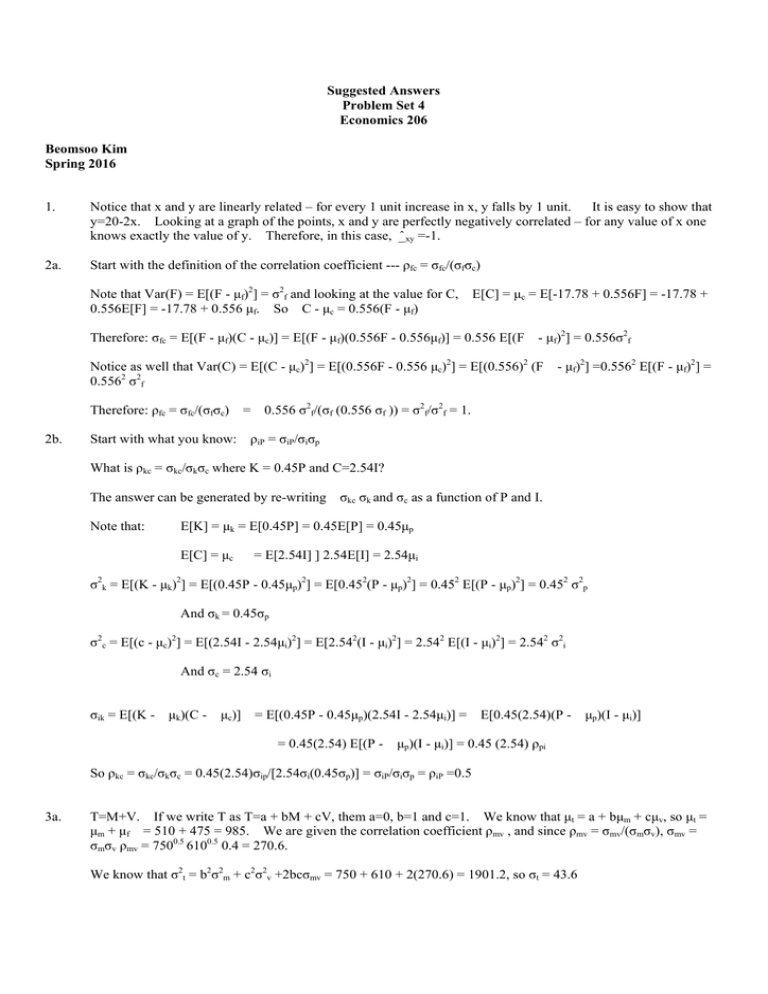Suggested Answers Problem Set 4 Economics 206 Beomsoo Kim
advertisement

Suggested Answers Problem Set 4 Economics 206 Beomsoo Kim Spring 2016 1. Notice that x and y are linearly related – for every 1 unit increase in x, y falls by 1 unit. It is easy to show that y=20-2x. Looking at a graph of the points, x and y are perfectly negatively correlated – for any value of x one knows exactly the value of y. Therefore, in this case, _ˆxy =-1. 2a. Start with the definition of the correlation coefficient --- ρfc = σfc/(σfσc) Note that Var(F) = E[(F - μf)2] = σ2f and looking at the value for C, 0.556E[F] = -17.78 + 0.556 μf. So C - μc = 0.556(F - μf) E[C] = μc = E[-17.78 + 0.556F] = -17.78 + Therefore: σfc = E[(F - μf)(C - μc)] = E[(F - μf)(0.556F - 0.556μf)] = 0.556 E[(F - μf)2] = 0.556σ2f Notice as well that Var(C) = E[(C - μc)2] = E[(0.556F - 0.556 μc)2] = E[(0.556)2 (F 0.5562 σ2f Therefore: ρfc = σfc/(σfσc) 2b. = - μf)2] =0.5562 E[(F - μf)2] = 0.556 σ2f/(σf (0.556 σf )) = σ2f/σ2f = 1. Start with what you know: ρiP = σiP/σiσp What is ρkc = σkc/σkσc where K = 0.45P and C=2.54I? The answer can be generated by re-writing σkc σk and σc as a function of P and I. Note that: E[K] = μk = E[0.45P] = 0.45E[P] = 0.45μp E[C] = μc = E[2.54I] ] 2.54E[I] = 2.54μi σ2k = E[(K - μk)2] = E[(0.45P - 0.45μp)2] = E[0.452(P - μp)2] = 0.452 E[(P - μp)2] = 0.452 σ2p And σk = 0.45σp σ2c = E[(c - μc)2] = E[(2.54I - 2.54μi)2] = E[2.542(I - μi)2] = 2.542 E[(I - μi)2] = 2.542 σ2i And σc = 2.54 σi σik = E[(K - μk)(C - μc)] = E[(0.45P - 0.45μp)(2.54I - 2.54μi)] = = 0.45(2.54) E[(P - E[0.45(2.54)(P - μp)(I - μi)] μp)(I - μi)] = 0.45 (2.54) ρpi So ρkc = σkc/σkσc = 0.45(2.54)σip/[2.54σi(0.45σp)] = σiP/σiσp = ρiP =0.5 3a. T=M+V. If we write T as T=a + bM + cV, them a=0, b=1 and c=1. We know that μt = a + bμm + cμv, so μt = μm + μf = 510 + 475 = 985. We are given the correlation coefficient ρmv , and since ρmv = σmv/(σmσv), σmv = σmσv ρmv = 7500.5 6100.5 0.4 = 270.6. We know that σ2t = b2σ2m + c2σ2v +2bcσmv = 750 + 610 + 2(270.6) = 1901.2, so σt = 43.6 3b. G = 0.25M + 0.75F. If we write G as G=a + bM + cF, then a=0, b=0.25 and c=0.75. bμm + cμf, so μg = (0.25)μm + (0.75)μf = (0.25)71 + (0.75)69 = 69.5 σ2 t We know that μg = a + = (0.25)2 σ2m + (0.75)2 σ2f + 2(0.25)(0.75)(19)σmσfρmf = (0.25)2 192 + (0.75)2 232 + 2(0.25)(0.75)(19)(23)(0.5) = 402 4. Let D1 be the value from the 1st die and D2 be the value on the second. T = D1 + D2. Three things to note E[D1]=E[D2] = 3.5 Var(D1) = Var(D2) = 1.712 =σ2 The values D1 and D2 are independent, so σ12 = 0 T = a + bD1 + cD2 where a=0, b=c=1 E[T] = E[D1] + E[D2] = 3.5 + 3.5 = 7 Var[T] = b2σ2 + c2σ2 + 2bcσ12 = σ2 + σ2 = 2σ2 = 2(1.71)2 = 5.85 Standard deviation for a pair of dice is then the square root of 5.85 or 2.42 5. Given a linear combination of random variables, Z = a + bY1 + cY2, we showed in class that Var(Z) = b2Var(Y1) + c2Var(Y2) + 2bcCov(Y1,Y2). In this case Z = Y1 + Y2 so a=0, b=1 and c=1. We are also given the fact that Y1 and Y2 have the same variance σ2y plus Y1 and Y2 are independent so we also know that Cov(Y1,Y2) = σ12 = 0. Plugging all these values into the equation above, Var(Z) = 2 σ2y – the same answer as in problem 4. 6. Given the results above, if Z = Y1 + Y2 + Y3 + ..... Yn and each value Yi is independent of Yj, then Var(Y1 + Y2 + Y3 + ..... Yn) = Var(Y1) + Var(Y2) + ..... Var(Yn) = nσ2y 7. Note that Var((1/n)Y1) = (1/n)2 Var(Y1) = σ2/n2, so Var(Z) = Var((1/n)(Y1 + Y2 + Y3 + ..... Yn)) = Var((1/n)Y2 + (1/n)Y2 + (1/n)Y3 + ...(1/n)Yn) And because each of the Y’s are independent (as in problem 6) =(1/n2)Var(Y1) + (1/n2)Var(Y2) + (1/n2)Var(Y3) + ...... (1/n2)Var(Yn) = (1/n2) σ2y + (1/n2) σ2y + (1/ n2) σ2y + ..... (1/n2) σ2y = nσ2/n2 = σ2/n Var(Z) =






